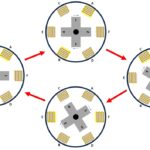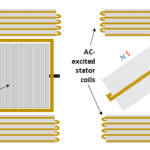You indeed can measure three-phase power in a motor with just two wattmeters.
Part 3 of this FAQ concluded with a simplified diagram showing a test setup that included a programmable power supply, a motor under test, a mechanical load, a power analyzer, and host computer. The programmable power supply could simulate the AC line for a line-connected motor or an AC or DC motor-drive output. I’m repeating the diagram here (Figure 1) for a three-phase AC system, and I have added a motor drive under test. In addition to measuring the motor’s electrical inputs and mechanical output, the Figure 1 setup measures the motor drive’s input and output power and voltage as well as the motor-drive internal DC bus current and voltage. Such a system enables end-to-end efficiency tests.

Aren’t you missing current sensors on phase 3 of the drive’s input and output?
Those two sensors are not necessary. Blondel’s theorem states that to measure the power of an n-conductor system, you only need n – 1 wattmeters: for example, two wattmeters for a three-phase system. Figure 2 includes a red wattmeter and a blue wattmeter, each including an ammeter and a voltmeter, for measuring the power into a wye (or star)-connected load. According to Blondel’s theorem, we just add the two wattmeter readings to get total power into the three-phase load: A1V1 + A2V2.

That’s not immediately obvious. How does this two-wattmeter technique work?
First, we can observe that the total instantaneous power PT in the wye-connected load is given by this equation:
PT = i1v1 + i2v2 + i3v3
If we have three wattmeters and access to the neutral point N in the wye-connected load of Figure 2, we can directly measure the power in each phase and add the power measurements together to get total power. But we may not have convenient access to N, and if we have a delta-connected load, the N point doesn’t even exist as a real circuit node.
OK, I understand the potential difficulties of the three-wattmeter method, but I’m still not convinced that the two-wattmeter method works.
Some simple algebra will demonstrate that it does. In Figure 2, observe that the red and blue ammeters measure i1 and i2, respectively, while the red and blue voltmeters measure the following voltages:
V1 = v1 – v3
V2 = v2 – v3
Multiplying each wattmeter’s ammeter and voltmeter readings gives us the following expressions:
A1V1 = i1v1 – i1v3
A2V2 = i2v2 – i2v3
Adding these two equations together in accordance with Blondel’s theorem yields the following equation:
A1V1 + A2V2 = i1v1 – i1v3 + i2v2 – i2v3
This equation can be arranged as follows:
A1V1 + A2V2 = i1v1 + i2v2 – i2v3 – i1v3 = i1v1 + i2v2 – (i1 + i2) v3
From Kirchhoff’s law, we know that the sum of i1, i2, and i3 is zero. Consequently:
i1 + i2 = –i3
Substituting –i3 for i1 + i2 yields the following equation:
A1V1 + A2V2 = i1v1 + i2v2 + i3v3
The right-hand side is identical to that of our original equation for total instantaneous power, demonstrating that the two-wattmeter method works.
How do these wattmeters fit into Figure 1? It looks like I’ll need two for the motor-drive input and two for the motor input.
The power analyzer performs the wattmeter function. You’ll need four power-analyzer channels, and hence four current sensors, to make both two-wattmeter measurements. In Figure 1, power-analyzer channels 1 and 2 constitute the two wattmeters for the motor, and channels 3 and 4 constitute the two wattmeters for the motor drive. Channel 5 measures the drive’s internal DC bus.
Where can I find more details?
Teledyne LeCroy has an article that describes using its MDA810 motor drive analyzer to make the two-wattmeter measurement and to perform line-line to line-neutral conversion. The article highlights the types of data the analyzer generates: RMS voltages and currents as well as real power in watts, reactive power in volt-amps-reactive (VARs), apparent power in volt-amps (VAs), and power factor.
Wait, how do real, reactive, and apparent power relate?
Real power is dissipated in resistive losses or delivered as useful work (as a motor would do). Reactive power is temporarily stored in system inductance and capacitance but ultimately returned to the source. Apparent power is the square root of the sum of the squares of real and reactive power, as shown in Figure 3.

What other types of motor test might I need to do?
Teledyne LeCroy has another article that covers using a power analyzer to perform mechanical as well as electrical measurements in an electric-vehicle propulsion motor. And of course, a power analyzer isn’t the only instrument you can use for motor test. Sometimes you’ll just want to measure winding resistance and inductance using an RLC meter, for example, or you will need to perform vibration tests. Hioki has a summary of the various types of motor tests you might want to perform and a description of the relevant instruments.





Learn more about how motors, power supplies, and other devices affect current harmonics from a webinar Harmonic Analysis on Distorted Waveforms on Thursday, 9 November at 11:00 AM ET, 8:00 AM PT. The webinar will be available on demand following the live presentation.